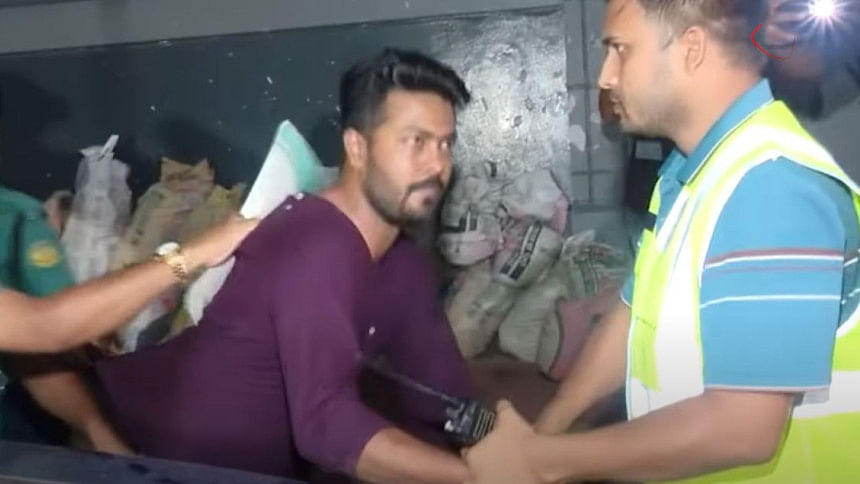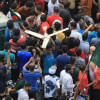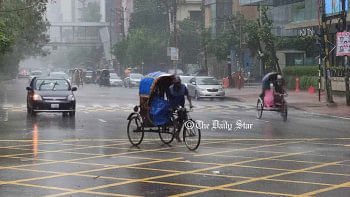When protest turns into a mob

The right to protest is a cornerstone of any democracy. From the 1952 Language Movement to the more recent July Uprising led by the Students Against Discrimination (SAD), Bangladesh's history has been shaped by the courage of its youth.
Movements like these have held the powerful accountable and voiced the frustrations of the marginalised.
But with that right comes a responsibility: to ensure that the means do not contradict the moral intent.
The recent incident in Dhanmondi, where several individuals affiliated with SAD attempted to storm the private residence of publisher Golam Mostafa, marks a troubling departure from that tradition.
Arriving at midnight and demanding his arrest without legal grounds or a formal case did not resemble a protest. The incident fits the definition of mob intimidation: when a group uses collective pressure, often outside legal boundaries, to compel action from individuals or institutions. It is coercion that undermines the very democratic norms the platform presumes to represent.
There are legitimate forms of protest—rallies, human chains, sit-ins, and non-cooperation programmes. But when protest intrudes into private spaces at night and seeks to punish through pressure instead of lawful process, it crosses a clear ethical line.
Golam Mostafa has clarified that he is not affiliated with any political party. He has published books by writers from various ideological backgrounds, including the Awami League. Unless a criminal offence has been committed, forced entry into his house and demanding arrest cannot be justified. It amounts to vigilantism.
According to police and video footage, a group of 15 to 20 individuals, including SAD Mohammadpur unit convener Saiful Islam Rabbiattempted to enter Mostafa's home on Monday night. They confronted the building's security guard. Then when the police came and took control of the scene, the group pressured officers to arrest Mostofa without even a case.
At one point of altercation with the group, police detained three of the them on the spot. They were, however, released the next afternoon.
The police deserve credit for preventing the situation from escalating. But their decision to release the individuals without filing charges raises concerns. When acts resembling mob intimidation go unaddressed legally, it risks normalising such behaviour under the guise of protest.
In the meantime, SAD severed its ties with Rabbi relieving him of his position, citing misconduct. This showed a willingness to uphold internal discipline.
But the matter became more complicated when Abdul Hannan Masud, a senior leader of the National Citizen Party (NCP), signed a bond to release the detainees. He later claimed that the activists had been "used" by external groups. Whatever the case may be, it does not excuse their actions.
His intervention also weakens SAD's internal accountability process. If someone removed for misconduct is publicly defended and released by a senior leader of the same outfit, it sends a mixed message.
It also gives the impression that political connections can protect individuals—even after wrongdoing.
This is exactly the kind of political influence and backdoor settlement that student movements have often spoken against. When public accountability is followed by quiet political intervention, people begin to question what the movement truly stands for.
Student movements have historically been engines of change. But their strength lies not just in mobilisation, but in values. At a time when democratic norms are fragile, the conduct of protesters and street campaigns set the tone for civic behaviour.
If progressive groups begin to rely on force, intrusion, or intimidation, how do they differ from the authorities they challenge? Protest must not imitate the very systems it seeks to reform.
The removal of Rabbi was a necessary first step. But SAD must now investigate: Who authorised the Dhanmondi action? What made activists believe it was justified? Was this an isolated act or a sign of deeper radicalisation? These questions matter; not just for public clarity, but for the movement's own moral direction.
A group cannot call for justice while tolerating impunity within its ranks.
More broadly, protest groups across the political spectrum must safeguard their credibility by staying within legal and ethical boundaries. Political leaders must refrain from interfering in disciplinary matters for short-term gain. The state, too, must treat acts of intimidation with the seriousness they deserve, regardless of who is involved.
A democracy cannot function when protest turns into mob pressure, or when wrongdoing is met with silence. It must be upheld not only through rhetoric, but also through uncompromising standards.
Because in the end, democracy is not simply about changing who holds power, it is about changing how power is used.

 For all latest news, follow The Daily Star's Google News channel.
For all latest news, follow The Daily Star's Google News channel. 






Comments